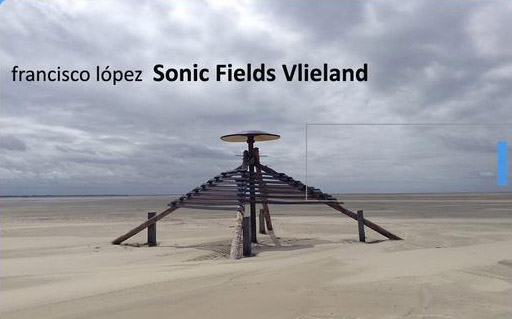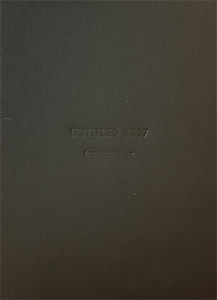 Taken together, these two recent releases from the always prolific Francisco López perfectly encapsulate not only the breadth of his work, but also the extreme duality of his approach. Sonic Fields Vlieland is a three hour, six segment piece made exclusively by treating field recordings captured on the Dutch island of Vlieland while Untitled #337 is a full-on technology-based work that utilizes software creation and the limitations of digital recording methodologies. Both works are very different in their sound and methods of composition, but both also showcase López’s exceptional artistry.
Taken together, these two recent releases from the always prolific Francisco López perfectly encapsulate not only the breadth of his work, but also the extreme duality of his approach. Sonic Fields Vlieland is a three hour, six segment piece made exclusively by treating field recordings captured on the Dutch island of Vlieland while Untitled #337 is a full-on technology-based work that utilizes software creation and the limitations of digital recording methodologies. Both works are very different in their sound and methods of composition, but both also showcase López’s exceptional artistry.
Nowhere Worldwide/Tsonami Records
Unlike his Epoché Collection of pure field recordings, Sonic Fields Vlieland is a hybrid of that style and his composed work.The material, all processed recordings from the island, is actually part of an installation of sorts on Vlieland.Visitors are encouraged to download a smartphone app that triggers the piece recorded on that section of the island via geolocation.While that tangible component is lost once the recordings are presented on a USB drive for listening anywhere, López’s work, as always, stands powerfully on its own merits.
"SFV1 (Forest Dip)" is the perfect amalgamation of composition and natural sounds.For the first half, rustling and birds are apparent sources, but his tweaking, layering, and what sounds like intentional clipping from his recording device come together into a mass of scraping sounds and echoing sputters.It does clearly have some dissonant qualities to it, but the sound itself never strays too far from its source.As the journey goes on, López’s processing becomes more pronounced and is less about the original material."SFV2 (Forest Hill)" and "SFV3 (Dune Crater)" largely feature the natural source material towards the forefront of the mix.The former features him processing distant birdsongs and eventually generating static-like noises, but the whole piece remains grounded by the sounds of nature.The latter also opens with chirping, the sounds of other wildlife and distant winds, but towards the end, treated and layered birds and sinister dissonant hums encroach into disorienting, disturbing territory.
For the second half, the recordings are less embedded in the natural elements they were sourced from, and instead begin to take on the character of López’s more traditionally composed works."SFV4 (Beach)" is a mass of crackling, filtered textures that have a more abstract, grinding quality to them than anything that could be expected from nature.At most there seems to be the recording of far off waves, but with the volume amplified to have an entirely different quality.The opening of "SFV5 (Polders)" sounds almost like the field recording of a bonfire, but reverberated and processed heavily.The piece transitions into a more ambient, spacious one, but soon upset by looped pseudo-rhythmic passages and louder textures.
The final segment, "SFV6 (West End)" clocks in at an hour alone, and is at least in its opening moments very spacious.Some resonating, distant sounds can be heard, into an almost bell-like tone.By the middle, it is an aggressive mix of white noise crashing and low end rumbling.The rhythmic throb becomes explosive here, and with the combination of that and the volume, it is a piece that edges into harsher noise territory.By the end it is back to extremely low frequencies and tiny, quiet fragments of field recording.
samples:
 
 At the other end of the spectrum is Untitled #337.Compared to the nature-sourced, uncompressed data beauty of Sonic Fields Vlieland, this work is derived from completely synthetic sources.Namely, the piece generated using the "Low-resolution High Definition Lópezsonics" system (at 16kbps) focuses on those sonic artifacts that are created from such low sound resolution as the composition itself.Originally an 80 minute private edition, digital only piece, here it is expanded to an absurd nine hours and presented on a data CDr.Perhaps most astounding is, due to the low resolution of the source material, the four pieces combined total a whopping 67 megabytes in size (about the size of a normal length album in mp3 format).
At the other end of the spectrum is Untitled #337.Compared to the nature-sourced, uncompressed data beauty of Sonic Fields Vlieland, this work is derived from completely synthetic sources.Namely, the piece generated using the "Low-resolution High Definition Lópezsonics" system (at 16kbps) focuses on those sonic artifacts that are created from such low sound resolution as the composition itself.Originally an 80 minute private edition, digital only piece, here it is expanded to an absurd nine hours and presented on a data CDr.Perhaps most astounding is, due to the low resolution of the source material, the four pieces combined total a whopping 67 megabytes in size (about the size of a normal length album in mp3 format).
Of course, this makes for a rather unique listening experience.The first part is an extremely low volume piece that requires some significant volume to actually be apparent.López’s frequent advisory to only listen with good headphones or speakers is always a good rule to follow, but for this work it would sound like absolutely nothing at all due to the extreme frequencies.With decent playback, the fragments of sound take on a shimmering, somewhat melodic quality to them, as low frequency tones rumble away.This flows into the second part, which clocks in at five hours by itself.The dynamic is even more hushed here, but the subtlest, simmering tones can be heard throughout.
The third part is a bit more commanding in volume, and the content could best be described as resembling the compression artifacts from an mp3 file from the late 1990s (when the codecs were a bit less advanced) extracted from the music and placed at the forefront.What is interesting is that, how these sounds once irritated me in music I may have illegally acquired now make for a unique and fascinating listening experience in their own right.The final segment turns the volume down even lower, but sounds like a combination of arctic winds and misfiring electronics.
The contrast here is stark:one release presented in a luxurious, uncompressed digital format and constructed from exquisitely detailed field recordings, and the other a ridiculously low resolution format and developed from purely electronic sources.This dichotomy though is representative of Francisco López’s extremely varied body of work that just seems to continue diversifying.He is prolific, but whenever I hear a new composition from him, I never know what to expect.It may be so subtle that I have to listen in complete isolation and at absurd volume levels, or it can be as harsh as any noise recording in my collection.It is for these exact reasons that he has been a brilliant composer for so long that constantly evolves and hones his craft to near perfection.
samples:
 
Read More

